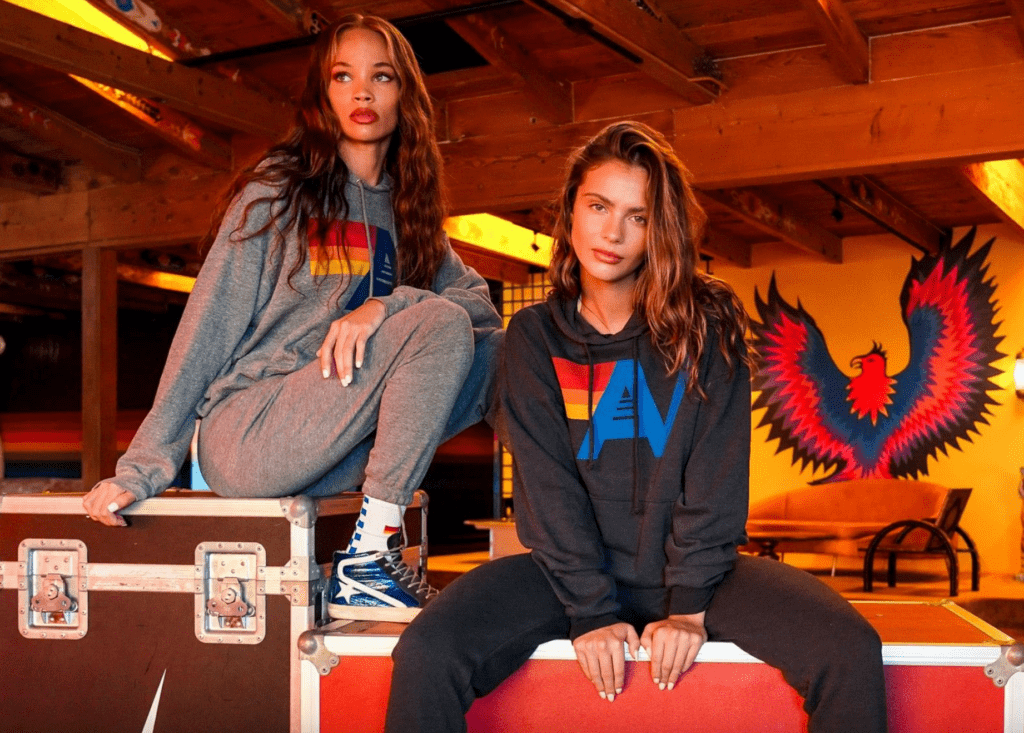The stripes-focused battle between adidas and Aviator Nation continues, with the California-based apparel upstart raising new arguments and counterclaims in its answer to the trademark infringement complaint waged against it by the German sportswear giant. And while the underlying conflict touches on various matters of contract and trademark law, the heart of the issue revolves around the companies’ respective uses of stripes.
For adidas, the dispute centers on Aviator Nation’s use of four- and five-stripe designs on apparel items, which adidas claims infringes on its iconic “three-stripe mark.” Meanwhile, for Aviator Nation, which claims adidas has gone back on the previous settlement agreements that the parties entered into and also has disadvantaged consumers by trying to withhold its rivals’ striped products, the dispute comes down to how many stripes is too many, or too few to constitute infringement of adidas’ well-known mark?
In the answer that it lodged with the U.S. District Court for the District of Oregon on June 21, Aviator Nation sets out an array of affirmative defenses, arguing, among other things, that adidas’ complaint should be barred in whole or in part by the doctrine of unclean hands. In furtherance of its defense, Aviator Nation asserts that adidas is actively trying to prevent it from using more or less than the three stripes that it maintains trademark rights in, which amounts to bullying.“ Adidas is misusing its ‘three-stripe mark’ to bully [Aviator Nation] away from designing, making, marketing and/or selling apparel incorporating two-, four-, and five-striped design elements, no matter their width, length, composition, direction, placement, spacing, color or other distinguishing features,” the company alleges in its answer.
Aviator Nation aims to bolster its unclean hands defense by way of claims that “adidas has led [it] to believe that [adidas] would not object to [its] manufacture and sale of two-, four-, and five-striped apparel designs only to lie in wait while … adidas developed new multi-colored three-striped clothing designs inspired by Aviator Nation’s own product designs and while [its] success grew over many years, so that adidas could return to complain about different designs, and differently-numbered striped designs, to exact further concessions and settlements that would unjustly enrich themselves and unfairly restrict [its] design options, all at [its] expense and to its detriment, and with no discernible benefit to consumers.”
At the same time, Aviator Nation wages “classic fair use and utilitarian and/or aesthetically functionality defenses,” asserting that while adidas stripes are a widely used design element in fashion that predate adidas’ three-stripe motif, the company is, nonetheless, using its three-stripe trademark to unfairly limit competition by objecting to other companies’ uses of any stripe designs, regardless of any distinct characteristics. Given that “stripes have been a common design feature for decades, if not for centuries,” and should not be monopolized by a single company, Aviator Nation argues that adidas’ attempts to prevent the use of stripes by others (including Aviator Nation) are unreasonable and harmful to both competing companies and consumers, alike.
Specifically, Aviator Nation argues that it “should not have to add many more than three stripes to its apparel to avoid adidas’ narrowly-circumscribed … trade dress rights as, to do so, would make it more costly, less aesthetically attractive, commercially impracticable, or, depending on those stripes’ articulation and placement on a garment, impossible, for Aviator Nation to design, make, market and sell striped apparel to consumers.”
Not finished there, Aviator Nation also asserts that adidas’ actions violate the 2022 settlement agreement the companies’ entered into, which was intended to settle the dispute over their respective stripe deigns once and for all. Aviator Nation contends that it has adhered to the terms of the agreement, but that adidas has failed to honor its own commitments, including that it would not initiate trademark infringement proceedings against Aviator Nation over various five-stripe designs, which are “protected by safe harbor provisions included in the 2022 agreement.”
With the foregoing in mind, Aviator Nation argues in a breach of contract counterclaim that by taking legal action against it, adidas is in breach of the parties’ 2022 settlement agreement. In a second counterclaim, Aviator Nation is seeking declaratory relief, namely, a finding from the court that it is not selling garments that infringe, unfairly compete with, or otherwise dilute adidas’ three-stripe mark, as its use of stripes is distinct from adidas’ trademark rights and thus, should not be conflated with the adidas’ three-stripe mark.
The burgeoning apparel brand emphasizes the importance of preserving its ability to use these stripe-centric designs, which have become integral to its brand identity, and thus, argues that such a declaration from the court is essential in order for it to “continue to manufacture, distribute, sell, and offer for sale apparel with five-stripe design elements like the designs now at issue, knowing it is protected from future and continuing disruption by adidas.”
Hardly the parties first foray in court, the legal friction between adidas and Aviator Nation dates back to at least 2019 when adidas filed a lawsuit alleging that the latter’s striped designs infringed on its famous three-stripe trademark. The two companies reached their most recent settlement agreement in 2022, which includes provisions to protect Aviator Nation’s use of certain striped designs.
The case is adidas America, Inc. v. Aviator Nation, Inc., 3:24-cv-00740 (D. Or.).

